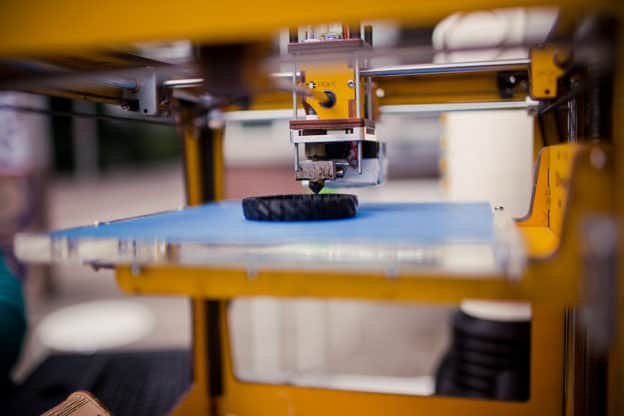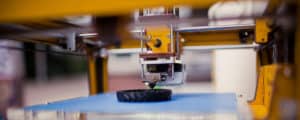
3D Printing is a growing field, and that means many variations of the technology are competing with one another. It reminds me of VHS vs. Beta or Blu Ray vs. HD DVD.
For most home setups we can narrow our search down to Fused Filament Fabrication (FFF)/Fused Deposition Modeling (FDM). These are the 3D printers that are most affordable right now, but there are multiple types of FFF printers out there, so what type is right for you? The answer for me, and most makers is a Cartesian 3D printer, but don’t count the others out just yet. Let me help you wrap your head around this tech.
What are the Types of FFF Printers?
There are currently four types of FFF printers. They are:
- Cartesian
- Delta
- Polar
- Selective Compliance Assembly Robotic Arm (SCARA)
Cartesian are by far the most popular, but there is a growing movement in the Delta community. Polar is different enough I don’t recommend going down this route unless you are very interested in it, but it is very cool. Last, but most interesting are the SCARA printers. You’ll learn more about them later.
[adinserter block=”1″]
Cartesian 3D Printers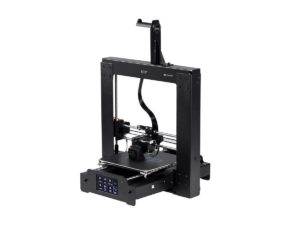
These printers got their name from the coordinate system they use to decide where to move and how to print. The Cartesian coordinate system uses X, Y and Z coordinates to tell the print head where to be positioned.
This is currently the most popular style of 3D printer in the desktop printer market.
Cartesian 3D printers typically have a rectangular or square bed that moves to account for the Y axis. The print head moves on a rail that will typically allow the head to move in the X axis. The rail for the print head is attached to another rail system that allows the print head to move up and down in the Z Axis.
The configuration described above is extremely stable, but there are other configurations for this method possible. The increased stability allows for some very precise printing.
Cartesian is the most common of the 3D Printer styles because it has been around for quite some time. There is already a large community out there for these printers, many are easily upgrade able, and more of the kinks have been worked out than with other models.
Most of the fully assembled inexpensive 3D printers under $400 dollars are Cartesian. If you’re interested in shopping for a Cartesian printer for your home setup this review will show you some interesting options available at Amazon.
Delta 3D Printers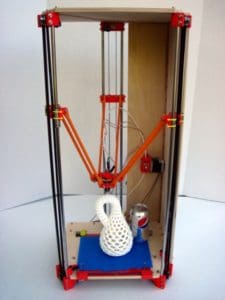
Delta printers look really cool, but that’s not the purpose of their creation. These printers use the same coordinate system as the Cartesian models, but the primary difference is in the armature holding the print head.
In the Delta model, the print bed is typically circular or similarly shaped. The extruder is positioned at the center of 3 arms suspended over the print bed in a triangular (Delta) fashion. This triangular rail positioning gives the printer style its name.
The Delta contains a number of hinges, and the arms move on rails to allow the print head to quickly move about in its print area. In fact, engineers created the Delta 3D printer style to improve the speed of 3D printing.
As an added benefit of this style, the print bed does not need to move.
While the Delta printers are faster at printing this does come at the price of a reduction in quality of prints. As you can imagine the stability of the arms is more difficult to control than that of the Cartesian model. Improving technology is closing the gap.
Additionally, the Delta models can get quite large quickly due to how the arms need to position.
Overall, most home makers don’t need speed as much as they desire precision. Yes, your print can take an extremely long time, but once it’s done, it’s the quality of the end result that really matters.
Polar 3D Printers
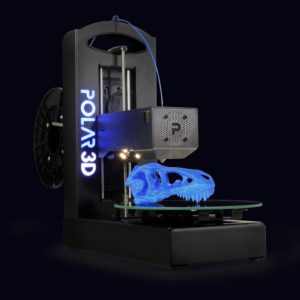
If you don’t like the Cartesian coordinate system for some reason there is another option (elitist… heh).
Polar 3D printers use a circular grid to describe the coordinate system. Essentially these printers move the bed forward, backward, and in circles to achieve any side to side movement. The print head simply moves up and down.
This creates a very stable print head position.
Polar 3D has really put together an interesting machine with this one. It boasts decent quality, easy setup, and use, and it’s super quiet.
Interestingly the Polar 3D targets schools and beginners.
The biggest drawback again lies in it’s differentiation from the popular. By using a different coordinate system Polar 3D printers separate themselves from a large body of resources available for Cartesian and Delta models.
Selective Compliance Assembly Robotic Arm (SCARA) 3D Printers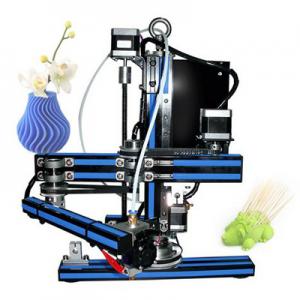
Getting into the realm of the possible, but needs work we find the SCARA.
These interesting machines are fascinating to watch and will remind you of videos you might see of large robots in factories. There needs to be more work on the SCARA frameworks, but they appear to be very precise which is very useful in creating more complex 3D objects.
In its current state SCARA is not as precise as the Cartesians, but it’s likely this is due to overall development time, and that could change.
Getting into a SCARA style printer would require a love of tinkering, and the desire to do something in a unique way most people are not using.
We love the makers out there experimenting with these. The videos of them printing are absolutely fantastic.
Which of the 3D Printer Styles is for you?
Which style are you going to choose when you get a 3D Printer?
I recommend the Cartesian if you are just getting started. It has the biggest community, best support, and lots of resources.
If you need speed, the Delta is a solid choice, but be aware you could be sacrificing quality.
While I think the Polar 3D and SCARA are cool, I’d stay away unless you really like being out there and messing with something unique. These would make fun secondary machines for a real tinkerer.

